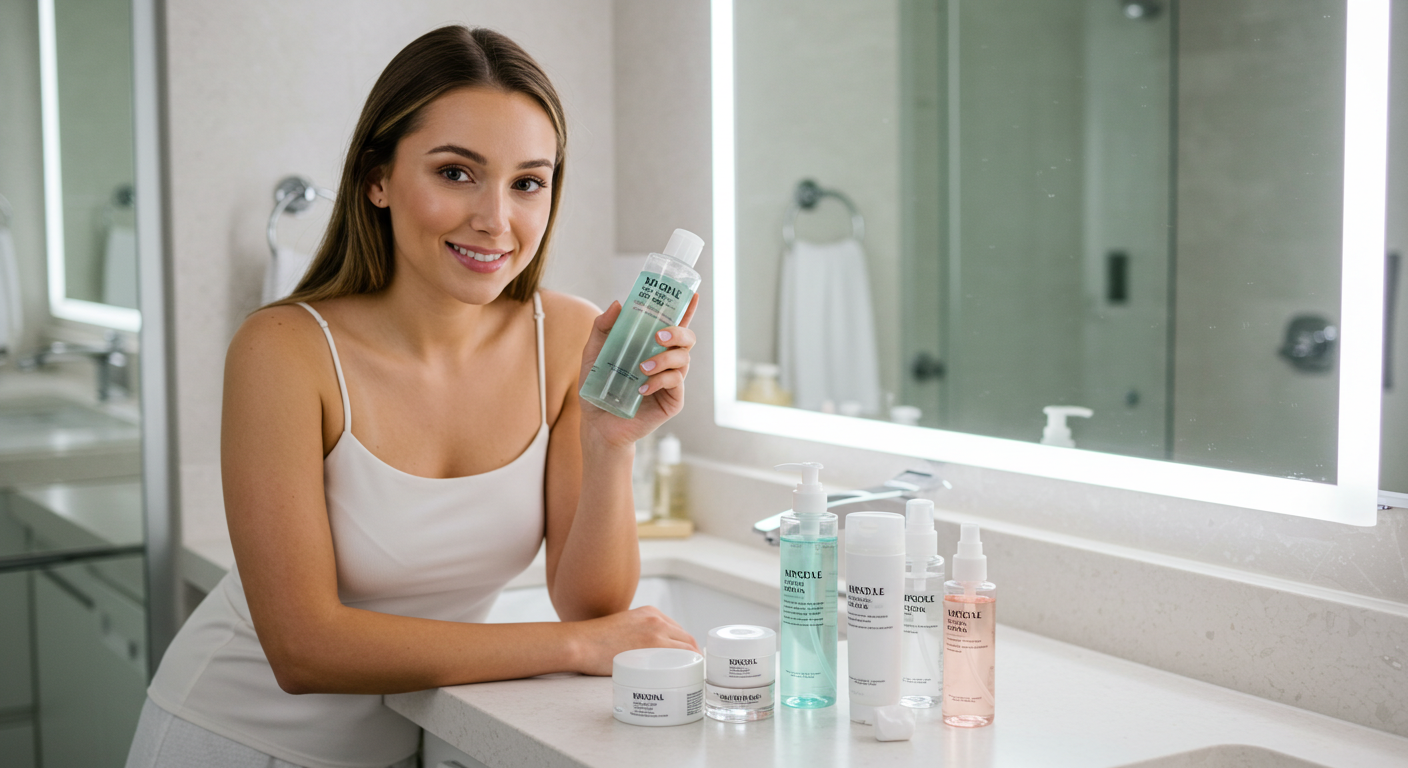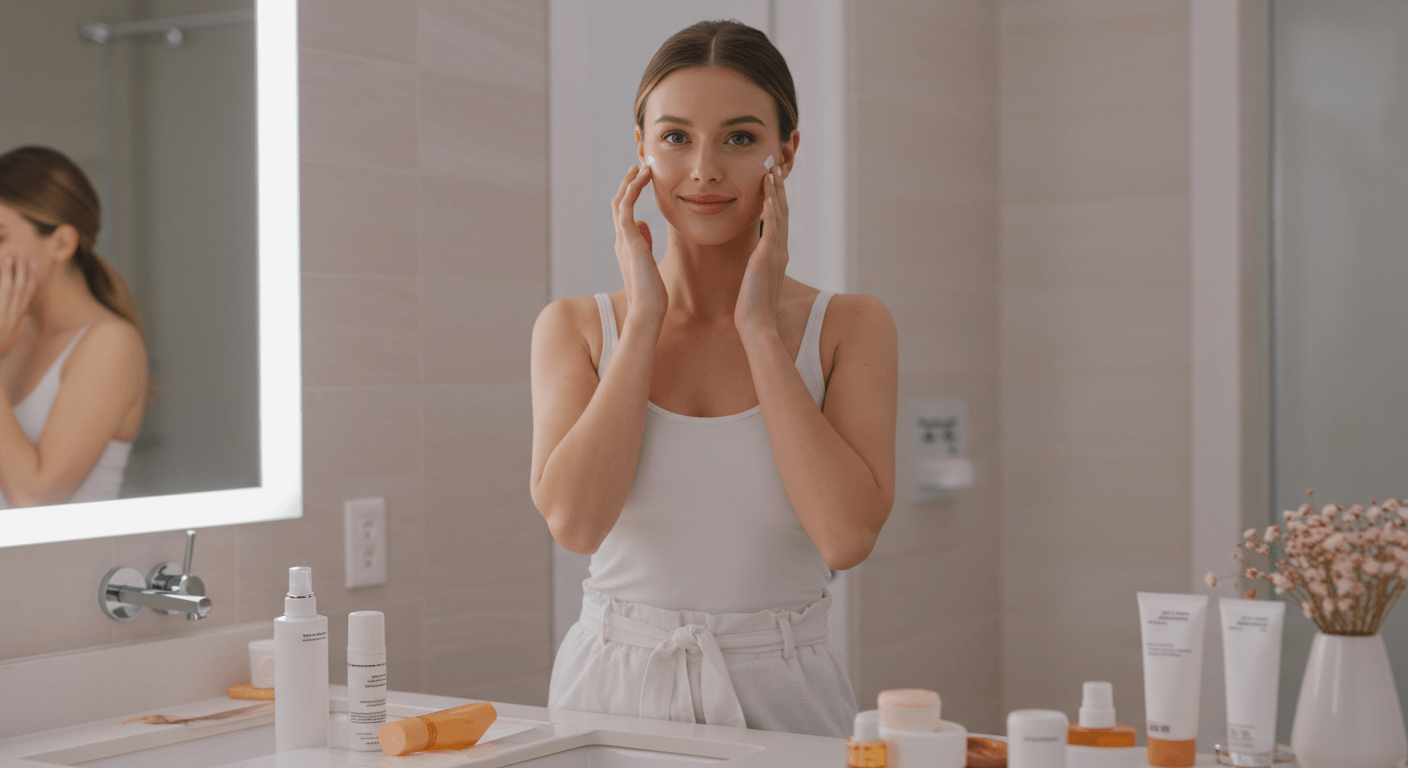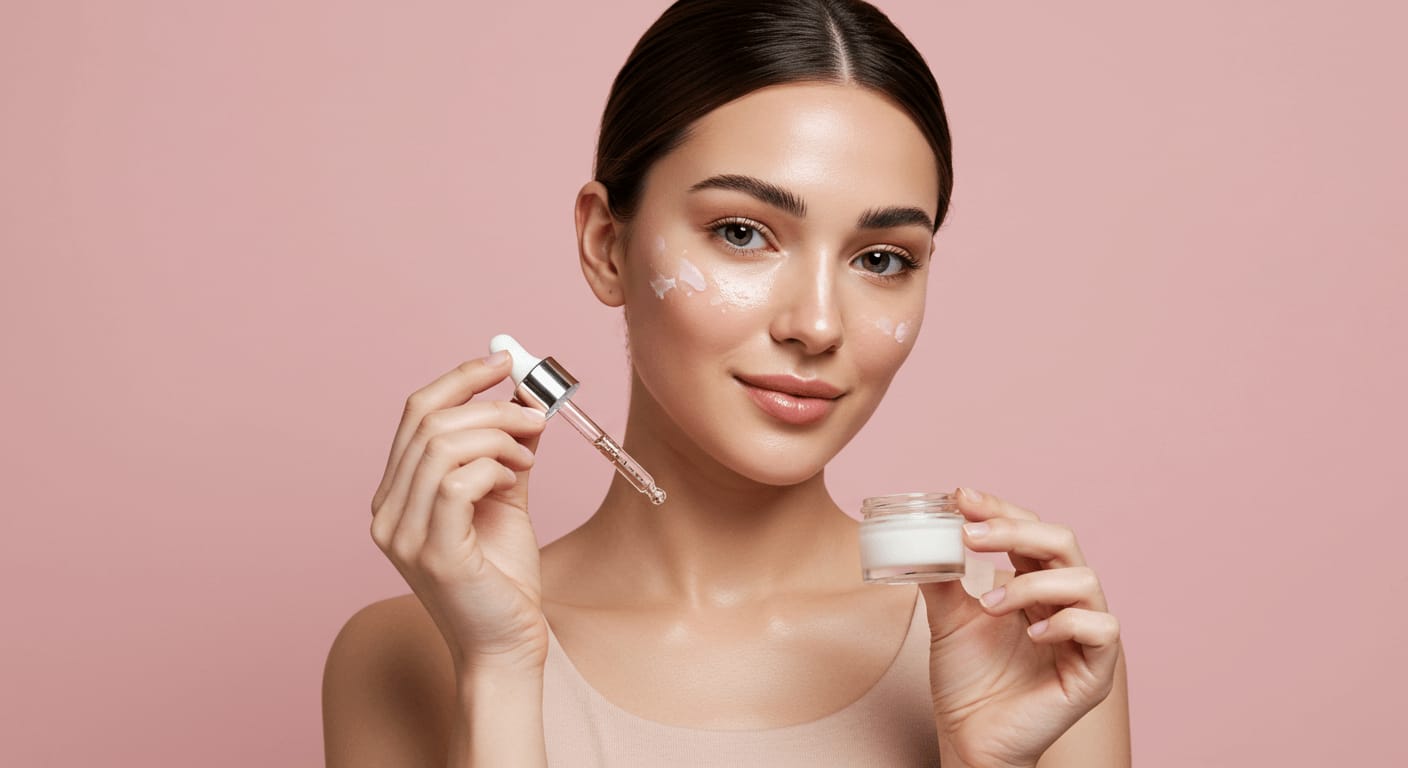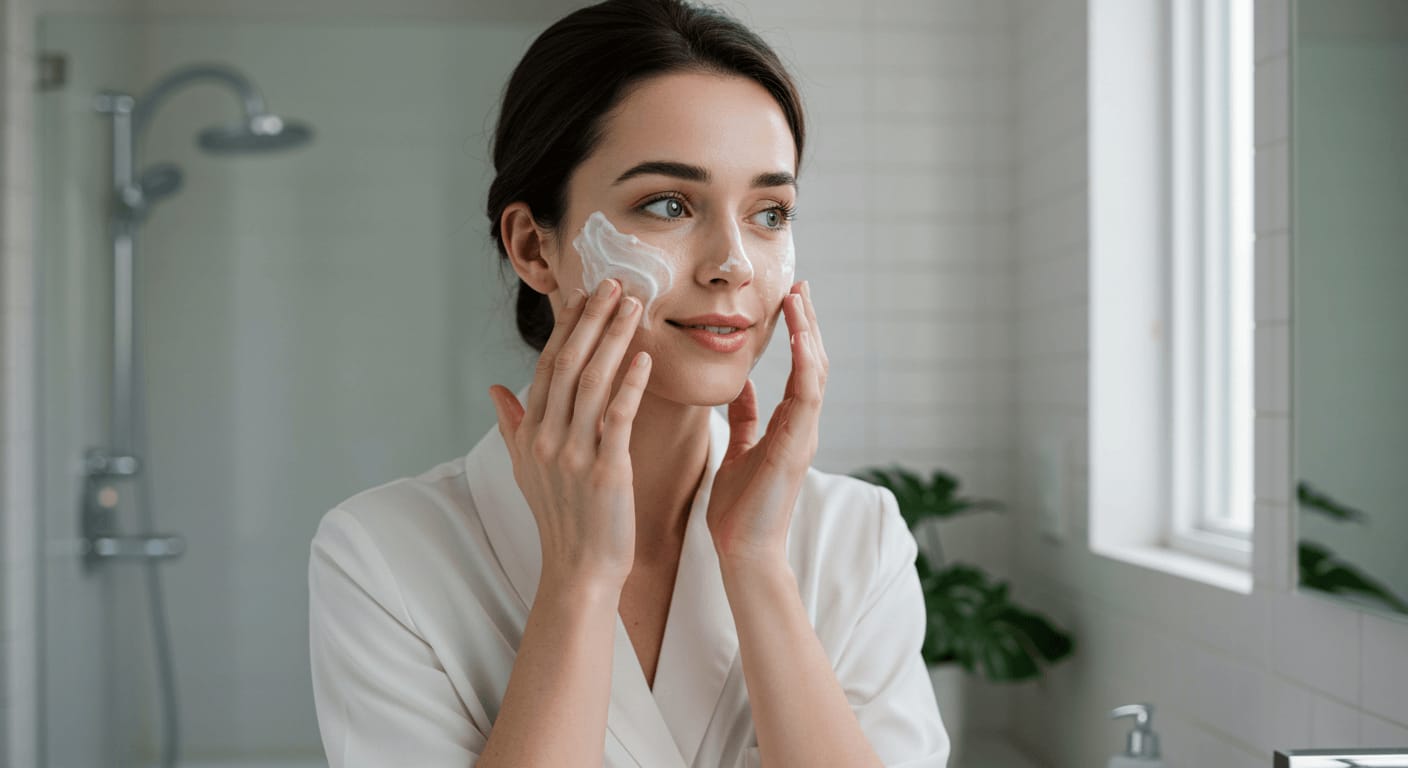Are you tired of dealing with inflamed skin that’s always on fire? You’re not alone! Redness and irritation can be a real nightmare, but don’t worry, you can fight back. By following the right skincare routine, you can soothe and calm your skin, reducing unwanted redness and irritation. Get ready to say goodbye to itchy and sensitive skin and hello to a radiant glow – it’s time to take control of your skin and start glowing!
Table of Contents
Key Takeaways: Steps For A Skincare Routine To Reduce Redness and Irritation
To achieve a skincare routine that reduces redness and irritation, consider the following points:
- Start with a gentle cleanser that is suitable for your skin type to avoid stripping your skin of its natural oils, which can exacerbate redness and irritation.
- Use soothing ingredients such as aloe vera, green tea, or chamomile, which have anti-inflammatory properties that can help calm the skin and reduce redness.
- Exfoliate carefully to remove dead skin cells and unclog pores, but be gentle to avoid further irritating the skin, and consider using a chemical exfoliant containing alpha-hydroxy acids or beta-hydroxy acids.
- Apply a moisturizer that is rich in emollients and humectants to help lock in moisture and soothe the skin, reducing the appearance of redness and irritation.
- Incorporate anti-redness products containing ingredients such as green tea extract or licorice extract, which have been shown to help reduce inflammation and redness.
- Be patient and give your skin time to adjust to new products and skincare routines, as it can take some time to see noticeable improvements in reducing redness and irritation.
- Keep your skincare routine consistent and simple, avoiding the use of too many products or ingredients that can irritate the skin and cause further redness and irritation.
Understanding Your Skin
A thorough understanding of your skin is the first step towards reducing redness and irritation. As you begin on this journey, you’ll discover that your skin is unique, with its own set of characteristics, needs, and quirks. To develop an effective skincare routine, you need to get familiar with your skin type, its strengths, and weaknesses. The key to achieving this is by identifying your skin’s specific needs and concerns, such as dryness, oiliness, or sensitivity. This will help you choose the right products and treatments that cater to your skin’s requirements.
The process of understanding your skin involves a bit of detective work, and it’s vital to break down the information into manageable chunks. The following table provides a snapshot of different skin types and their characteristics:
| Skin Type | Characteristics |
|---|---|
| Normal | Balanced, neither too oily nor too dry |
| Dry | Tight, flaky, and prone to irritation |
| Oily | Shiny, greasy, and prone to acne |
| Combination | Both oily and dry areas, often on the T-zone |
| Sensitive | Prone to redness, irritation, and allergic reactions |
This will give you a better understanding of your skin type and help you navigate the world of skincare with confidence.

Identifying Types of Sensitive Skin
The most important thing you can do for your skin is to understand its unique needs and concerns. You may have rosacea, eczema, or psoriasis, which require special care and attention. To identify your skin type, look out for the following:
- Redness and irritation after using certain products
- Itchiness and stinging sensations on your skin
- Flakiness and dryness in certain areas
This will help you narrow down your skin concerns and develop a tailored approach to addressing them.
Factors That Cause Redness and Irritation
Your skin is a delicate balance of moisture, oil, and pH levels, and any disruption to this balance can cause redness and irritation. You may experience inflammation due to various factors, including:
- Harsh products that strip your skin of its natural oils
- Environmental stressors like pollution and UV radiation
- Dietary factors such as spicy or acidic foods
The key to reducing redness and irritation is to identify and address these underlying factors.
This is especially true when it comes to skincare routines and product choices. You should be aware of the potential triggers that can cause redness and irritation, such as:
- Artificial fragrances and dyes
- Exfoliating too frequently or aggressively
- Using hot water instead of warm or cool water
The most important thing you can do is to be gentle with your skin and listen to its needs, and The best approach is to start with a simple skincare routine and gradually introduce new products and treatments as your skin becomes more resilient.
Tips and Tricks
You are probably aware that creating a skincare routine to reduce redness and irritation requires patience, dedication, and the right approach. To achieve the best results, you should focus on using gentle products that are suitable for your skin type, and avoid any harsh chemicals that can cause further irritation. Here are some tips to keep in mind:
- Always read the labels carefully and look for soothing ingredients like aloe vera or green tea
- Avoid exfoliating too frequently, as this can strip your skin of its natural oils
- Keep your skincare routine simple and consistent, and give your skin time to adjust to new products
By following these tips, you can minimize the risk of adverse reactions and achieve a more even-toned complexion. Recognizing the importance of a gentle skincare routine is the first step towards reducing redness and irritation.
As you continue on your skincare journey, you will likely encounter a variety of products that claim to reduce redness and irritation. You should be cautious of false claims and always patch test new products before incorporating them into your routine. By taking the time to educate yourself on the different ingredients and products available, you can make informed decisions about what works best for your skin. This will help you avoid common mistakes and achieve the glowing complexion you desire.

Advice for Choosing Gentle Products
Any effort you put into choosing the right products will be worth it in the long run, as using gentle and non-irritating products is imperative for reducing redness and irritation. You should look for products that are labeled as hypoallergenic or fragrance-free, as these are less likely to cause a negative reaction. Additionally, you should opt for products that contain soothing ingredients like aloe vera or green tea, which can help to calm and comfort your skin.
Any questions you have about a particular product should be answered by reading online reviews or consulting with a dermatologist. They can provide you with valuable advice and help you make informed decisions about your skincare routine. By taking the time to research and understand the different products available, you can create a skincare routine that is tailored to your specific needs and helps to reduce redness and irritation.
Lifestyle Changes to Reduce Irritation
The key to reducing redness and irritation is not just about the products you use, but also about making healthy lifestyle choices. You should try to manage stress, as high levels of stress can cause inflammation and lead to redness and irritation. Additionally, you should aim to get enough sleep and stay hydrated, as this can help to regulate your skin and reduce inflammation.
Understanding how your lifestyle choices impact your skin is imperative for reducing redness and irritation. You should be aware that smoking and excessive sun exposure can cause premature aging and lead to a range of skin problems, including redness and irritation. By making a few simple changes to your daily routine, such as wearing sunscreen and avoiding smoky environments, you can help to protect your skin and achieve a healthier complexion.
Step-by-Step Skincare Routine
Despite the overwhelming number of skincare products on the market, creating a simple and effective skincare routine can be a challenge. You want to make sure you’re using the right products for your skin type, and that you’re using them in the right order. To help you get started, we’ve broken down a basic skincare routine into a simple table:
| Product | Benefits |
|---|---|
| Cleanser | Gently removes dirt and impurities without stripping your skin of its natural oils |
| Toner | Helps balance your skin’s pH and prepares it for further products |
| Moisturizer | Hydrates and protects your skin from environmental stressors |
By following this basic routine, you can help reduce redness and irritation and achieve healthier, more radiant skin.
Along with the basic skincare routine, it’s also important to consider your specific skin concerns and needs. If you have acne-prone skin, you may want to look for products that contain salicylic acid or benzoyl peroxide, which can help to reduce inflammation and prevent breakouts. On the other hand, if you have dry or sensitive skin, you may want to look for products that are fragrance-free and hypoallergenic, which can help to soothe and calm your skin.

Morning Skincare Steps
Actually, starting your day with a consistent skincare routine can make a big difference in how your skin looks and feels. You’ll want to begin by washing your face with a gentle cleanser that’s suitable for your skin type. Next, apply a toner to help balance your skin’s pH and prepare it for the products that follow. Finally, apply a lightweight moisturizer that won’t clog your pores or interfere with your makeup.
Additionally, don’t forget to apply a broad-spectrum sunscreen with an SPF of at least 30 to protect your skin from harmful UV rays. You can choose a physical sunscreen that contains zinc oxide or titanium dioxide, which can provide immediate protection against the sun’s rays. By following these simple steps, you can help keep your skin healthy and protected all day long.
Nighttime Skincare Steps
Fortunately, your nighttime skincare routine can be a bit more extensive than your morning routine, as you’re not worried about applying makeup or dealing with the stresses of the day. You’ll want to start by removing your makeup with a gentle makeup remover, followed by a cleanser that’s suitable for your skin type. Next, apply a toner to help balance your skin’s pH and prepare it for the products that follow.
For example, if you have dry or sensitive skin, you may want to apply a rich moisturizer or a facial oil to help lock in moisture and soothe your skin. On the other hand, if you have acne-prone skin, you may want to apply a spot treatment that contains salicylic acid or benzoyl peroxide to help reduce inflammation and prevent breakouts.
Skincare routines can be highly individualized, and what works for one person may not work for another. So, be patient and don’t be afraid to experiment until you find a routine that works for you. Keep in mind that it may take some time to see noticeable results, so stick with it and give your skin the time it needs to adjust. By following a consistent skincare routine and using products that are suitable for your skin type, you can help reduce redness and irritation and achieve healthier, more radiant skin.
Common Mistakes to Avoid
Your skincare routine is a delicate balance of products and techniques, and making mistakes can lead to more harm than good. As you strive to reduce redness and irritation, it’s vital to be aware of the pitfalls that can throw your skin off balance. One of the most common mistakes is over-exfoliating, which can strip your skin of its natural oils and lead to irreversible damage. On the other hand, under-moisturizing can cause dryness and irritation, making your skin more prone to redness and inflammation.
Your goal is to find a balance that works for your skin type, and this requires patience and attention to detail. By avoiding common mistakes, you can create a skincare routine that nourishes and protects your skin, rather than causing harmful side effects. So, what are the mistakes to watch out for? Let’s investigate the details.

Over-Exfoliating and Under-Moisturizing
You might be tempted to exfoliate daily, but this can be a recipe for disaster. Over-exfoliating can lead to micro-tearing of the skin, causing irritation and redness. On the other hand, under-moisturizing can cause dryness and tightness, making your skin feel uncomfortable and sensitive. You need to find a balance between exfoliating enough to remove dead skin cells and moisturizing enough to keep your skin hydrated and plump.
You should also be mindful of the products you use and how they interact with your skin. Using the right products in the right amounts can make all the difference in achieving healthy and glowing skin. By being gentle and consistent, you can avoid the pitfalls of over-exfoliating and under-moisturizing and create a skincare routine that nourishes and protects your skin.
Using Harsh Products
You might think that using harsh products will get you faster results, but the truth is that these products can cause long-term damage to your skin. Harsh products can strip your skin of its natural oils, leading to dryness and irritation. You should opt for gentle, natural products that work with your skin, rather than against it. By choosing the right products, you can avoid irritation and redness and achieve the glowing skin you desire.
You should always patch test new products before using them on your face to ensure that you don’t have any adverse reactions. This simple step can save you from potential disasters and help you find the products that work best for your skin.
Plus, when using harsh products, you’re not only causing immediate damage, but you’re also increasing your skin’s sensitivity over time. This can lead to a cycle of irritation and inflammation that’s difficult to break. By opting for gentle, effective products and being mindful of your skin’s needs, you can create a skincare routine that soothes and calms your skin, rather than causing harm and irritation.
Pros and Cons of Different Skincare Products
After scouring the market for the perfect skincare products to reduce redness and irritation, you’re likely to be overwhelmed by the numerous options available. As you research into the world of skincare, you’ll encounter a plethora of products, each with its own set of advantages and disadvantages. To help you make an informed decision, let’s take a look at the pros and cons of different skincare products.
| Product Type | Pros and Cons |
|---|---|
| Natural Products | Gentle, Non-irritating, but may not be as effective as chemical-based products |
| Chemical-Based Products | Fast-acting, Effective, but may contain harsh ingredients that can irritate your skin |
| Moisturizers | Hydrating, Soothing, but may clog pores if not chosen correctly |
| Exfoliants | Exfoliates, Brightens, but may be too harsh for sensitive skin |
| Serums | Concentrated, Targeted, but may be expensive and not suitable for all skin types |
As you can see, each product type has its own set of pros and cons, and it’s imperative to weigh these factors when choosing the right products for your skincare routine.
As you navigate the world of skincare, you’ll encounter various products that claim to reduce redness and irritation.

Natural vs. Chemical-Based Products
ChemicallyBased products may seem like a quick fix, but they can have long-term consequences for your skin. On the other hand, natural products are often gentler and more sustainable, but may not be as effective. Regarding natural products, you’ll find that they are often free from harsh ingredients and are a great option for those with sensitive skin. However, they may not be as effective as chemical-based products, and you may need to be patient and give them time to work.
Benefits and Drawbacks of Each
Beneficially, natural products are a great option for those who want to avoid harsh chemicals and artificial fragrances. You’ll find that natural products are often rich in antioxidants and soothing ingredients that can help calm your skin. However, they may not be as fast-acting as chemical-based products, and you may need to use them consistently to see results.
This is where chemical-based products come in – they can provide quick relief from redness and irritation, but they may contain harsh ingredients that can irritate your skin in the long run. As you weigh the benefits and drawbacks of each, you’ll need to consider your skin type, concerns, and lifestyle to make an informed decision. You should always patch test new products and start with a small amount to ensure you don’t irritate your skin. By being aware of the pros and cons of different skincare products, you can make informed decisions and find the perfect products to reduce redness and irritation, and achieve the glowing, healthy skin you deserve.
Customizing Your Routine
To get the most out of your skincare routine and reduce redness and irritation, you need to tailor it to your specific skin type and concerns. This means taking into account your skin’s unique characteristics, such as its tone, texture, and any conditions you may have, like acne or rosacea. By doing so, you’ll be able to create a routine that addresses your individual needs and helps you achieve the healthy, glowing complexion you desire. You’ll be able to say goodbye to irritation and inflammation, and hello to a more even-toned and radiant skin.
As you customize your routine, you’ll want to consider a variety of factors, including the products you use, the frequency of application, and the techniques you employ. This may involve some trial and error, as you figure out what works best for your skin. But don’t worry, with a little patience and persistence, you’ll be able to find the perfect combination of products and practices that leave your skin looking and feeling its best. And when you do, you’ll be amazed at the difference it can make in your overall appearance and confidence.

Considering Skin Tones and Concerns
Considering your skin tone and concerns is vital when customizing your skincare routine. If you have fair skin, you may need to take extra precautions to protect it from the sun and environmental stressors, while those with darker skin tones may need to focus on finding products that won’t dry out or irritate their skin. Similarly, if you have sensitive skin, you’ll want to opt for gentle, fragrance-free products that won’t cause redness or irritation. By taking these factors into account, you can create a routine that addresses your unique skin concerns and helps you achieve the healthy, glowing complexion you desire.
Considering your individual skin concerns, such as acne, hyper-pigmentation, or fine lines, is also vital when customizing your routine. This may involve using products that contain salicylic acid or benzoyl peroxide to help control breakouts, or retinol or peptides to reduce the appearance of wrinkles. By targeting your specific skin concerns, you can create a routine that helps you achieve the smooth, youthful complexion you’ve always wanted.
Adjusting Your Routine Seasonally
Clearly, the changing seasons can have a big impact on your skin, and adjusting your routine accordingly can make a huge difference. As the weather changes, your skin’s needs may shift, and you may need to switch up your products and practices to keep your skin looking and feeling its best. For example, during the winter months, you may need to use a richer moisturizer to combat dryness and irritation, while in the summer, you may need to opt for a lighter, oil-free formula to help control shine and breakouts.
For instance, if you live in an area with harsh winters, you may need to take extra precautions to protect your skin from the cold and wind. This might involve using a thick, nourishing moisturizer to lock in hydration, as well as a broad-spectrum sunscreen to prevent sun damage. On the other hand, if you’re experiencing a hot and humid summer, you may need to focus on using light, non-comedogenic products that won’t clog pores or exacerbate oiliness. By adjusting your routine seasonally, you can help your skin stay healthy, balanced, and radiant all year round, and avoid irritation, dryness, and other common skin concerns. This will help you maintain a positive and confident attitude towards your skin, and ensure you look and feel your best.
Final Words
Now that you’ve got the lowdown on the steps for a skincare routine to reduce redness and irritation, it’s time to put your new knowledge into action. You’re probably excited to start saying goodbye to that pesky redness and hello to a clearer, calmer complexion. As you begin on this skincare journey, keep in mind that everyone’s skin is different, so be patient and don’t be too hard on your skin if it takes some trial and error to find what works best for you. Your skin will thank you for taking the time to understand its unique needs and quirks.
For a more in-depth look at how to reduce redness on your face, check out Skin care routine & treatment: How to reduce redness on your face with the right treatments and ingredients. You’ll find tons of valuable tips and tricks to help you customize your skincare routine and tackle redness and irritation once and for all. With a little persistence and the right guidance, you’ll be on your way to a more even-toned, radiant complexion in no time – and you’ll be wondering how you ever managed without these strategies in your skincare arsenal! As you move forward, always keep your skin’s unique needs top of mind, and don’t hesitate to seek out new advice and insights to keep your skincare game strong. You got this, and your skin will thank you!
FAQ:
Q: What ingredients should I look for in skincare products to help reduce redness and irritation?
A: To start a skincare routine focused on reducing redness and irritation, begin by identifying your skin type and concerns. This will help you choose the right products for your skin. Then, cleanse your face gently with a fragrance-free cleanser suitable for your skin type, followed by a toner to balance your skin’s pH. Apply a soothing serum or treatment product containing ingredients like aloe vera, green tea, or chamomile to help calm and reduce redness.
Q: How often should I exfoliate to reduce redness and irritation without causing further irritation?
A: Exfoliating is an crucial part of any skincare routine, but it’s especially sensitive when dealing with redness and irritation. It’s recommended to exfoliate one to three times a week, depending on your skin type and how your skin reacts. For sensitive skin prone to redness, chemical exfoliants containing alpha-hydroxy acids (AHAs) or beta-hydroxy acids (BHAs) at lower concentrations can be more gentle than physical exfoliants. Always patch test a new exfoliant on a small area of your skin before using it on your face to check for any adverse reactions.
Q: What ingredients should I look for in skincare products to help reduce redness and irritation?
A: When looking for skincare products to reduce redness and irritation, focus on ingredients known for their soothing and anti-inflammatory properties. Some key ingredients include niacinamide, which can help improve the skin’s barrier function; hyaluronic acid, for its moisturizing and soothing effects; and antioxidants like vitamin C or vitamin E, which protect the skin from environmental stressors. Additionally, ingredients such as aloe vera, green tea, and chamomile are renowned for their calming effects on the skin.
Q: Can makeup and sunscreen contribute to redness and irritation, and how can I choose products that won’t exacerbate these issues?
A: Yes, certain makeup and sunscreen products can contribute to redness and irritation, especially if they contain harsh chemicals, dyes, or fragrances. When choosing makeup, opt for products labeled “hypoallergenic” or “fragrance-free” as they are less likely to cause irritation. For sunscreen, select a physical sunscreen containing zinc oxide or titanium dioxide, as these mineral active ingredients are generally gentle on the skin and provide a barrier against UV rays without penetrating too deeply into the skin. Always apply a small amount of any new product to a discrete area of your skin for a few days before using it on your face to ensure you don’t have a reaction.
Q: How long does it typically take to see improvements in redness and irritation when starting a new skincare routine?
A: The time it takes to see improvements in redness and irritation can vary significantly from person to person, depending on the severity of the condition, the effectiveness of the products used, and individual skin characteristics. Generally, you might start to notice some improvements within a few weeks, such as reduced inflammation or less frequent flare-ups. However, it can take up to 2-3 months for the skin to fully adjust and for the effects of the new skincare routine to become fully apparent. Consistency with your skincare routine and patience are key, as everyone’s skin responds at its own pace.

























0 Comments